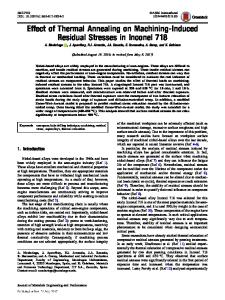Evolution of the microstructure, residual stresses, and mechanical properties of W-Si-N coatings after thermal annealing
- PDF / 1,542,422 Bytes
- 13 Pages / 612 x 792 pts (letter) Page_size
- 68 Downloads / 351 Views
Fernandes Centro de Engenharia Mecaˆnica da Universidade de Coimbra, Dep. de Engenharia Mecânica, Universidade de Coimbra, 3030 Coimbra, Portugal
N.J.M. Carvalho and J.Th. De Hosson Department of Applied Physics and Netherlands Institute for Metals Research, University of Groningen, Nijenborgh 4, The Netherlands (Received 19 August 2004; accepted 24 February 2005)
W–Si–N films were deposited by reactive sputtering in a Ar + N2 atmosphere from a W target encrusted with different number of Si pieces and followed by a thermal annealing at increasing temperatures up to 900 °C. Three iron-based substrates with different thermal expansion coefficients, in the range of 1.5 × 10−6 to 18 × 10−6 K−1 were used. The chemical composition, structure, residual stress, hardness (H), and Young’s modulus (E) were evaluated after all the annealing steps. The as-deposited film with low N and Si contents was crystalline whereas the one with higher contents was amorphous. After thermal annealing at 900 °C the amorphous film crystallized as body-centered cubic ␣–W. The crystalline as-deposited film presented the same phase even after annealing. There were no significant changes in the properties of both films up to 800 °C annealing. However, at 900 °C, a strong decrease and increase in the hardness were observed for the crystalline and amorphous films, respectively. It was possible to find a good correlation between the residual stress and the hardness of the films. In several cases, particularly for the amorphous coating, H/E higher than 0.1 was reached, which envisages good tribological behavior. The two methods (curvature and x-ray diffraction) used for calculation of the residual stress of the coatings showed fairly good agreement in the results. I. INTRODUCTION
Tungsten-based coatings deposited by sputtering have many applications such as diffusion barriers,1 semiconductor devices,2 and hard coatings.3 Doping W films with an increasing concentration of elements such as Si and N by sputtering provide the possibility of various structures, i.e., metallic phases, nitrides, and even amorphous structures.4 In these films, Si is bonded preferentially to N forming an amorphous Si–N phase that, in conjunction with nanograins of W-based phases, gives rise to a nanocomposite material.5 Two amorphous phases are expected, one rich in Si and the other in W. Detailed knowledge of the thermal behavior of hard coatings is important because in many applications, the service temperature can reach temperatures up to
a)
Address all correspondence to this author. e-mail: [email protected] DOI:10.1557/JMR.2005.0169 1356
J. Mater. Res., Vol. 20, No. 5, May 2005
1000 °C. Another aspect is the possibility of reaching interesting “nanocomposite” structures by the crystallization of as-deposited amorphous coatings via thermal annealing. Of the several hardening factors intervening for reaching a very high hardness in these films, the residual stresses is one of the most important.6,7 Taking into account that the residual stress is mainly due to
Data Loading...











